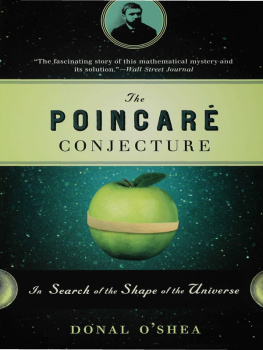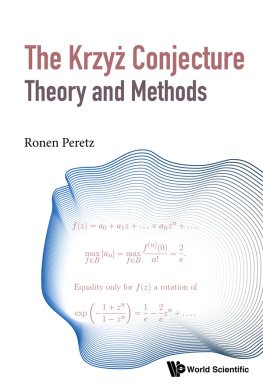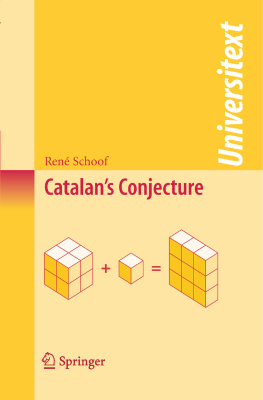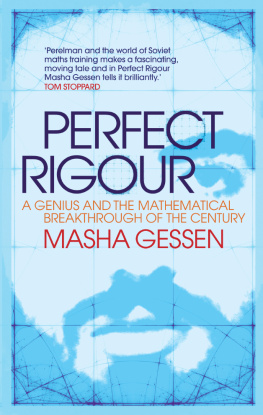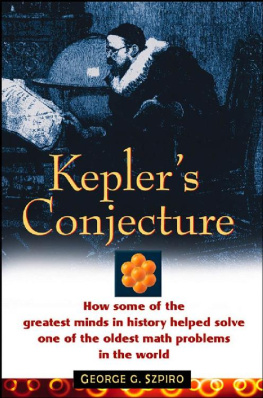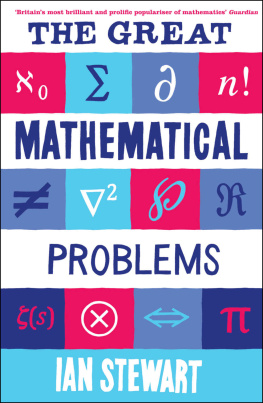Praise forThe Poincar Conjecture
"O'Shea's approach is more narrative than technical, but he conveys the gist of topology's mind-bending contortions with great flair."
NewScientist
"The Poincar conjecture is a guess about these higher-dimensional surfaces. If these ideas are hard to imagineand they arethey are harder yet to prove In The Poincar Conjecture, Mr. O'Shea tells the fascinating story of this mathematical mystery and its solution by the eccentric Mr. Perelman."
Wall Street Journal
"O'Shea, a mathematician, recounts the rich history of the famous problem and its solution, even managing to connect its abstract implications to the real world. A layman's guide to this mathematical odyssey is long overdue, and this one will appeal to math whizzes and interested novices alike."
Discover
"At the genial center of this story is Poincar, who made his mark by unifying geometrical, topological and algebraic approaches to vital questions in math and physics. O'Shea describes how Poincar developed his famous question For a lay person, it takes the rest of the book to do justice to the full statement of the conjecture, and it is worth the effort."
Chicago Tribune
"Donal O'Shea tells the whole story in this book, neatly interweaving his main theme with the history of ideas about our planet and universe. There is good coverage of all the main personalities involved, each one set in the social and academic context of his time."
New York Sun
"Donal O'Shea, an accomplished topologist, tells the story of Perelman's proof, and what led up to it, for a general audience The Poincar Conjecture makes one of the most important developments in today's mathematics accessible to a wide audience, and it deserves to be widely read."
Toronto Globe and Mail
"Donal O'Shea's beautifully written book, The Poincar Conjecture, begins with a quick tour of the history of ideas of geometry and topology that set the stage for Poincar. [O'Shea] has a gift for metaphor and often is able to capture the essence of a mathematical development or idea without falling into the jargon of the discipline or impenetrable prose The Poincar Conjecture is a fine example of mathematical writing for a general audience."
American Scientist
"Even if I felt that after the third chapter I had the sort of mind powerful enough to bend spoons, I was still dazzled by what I was learning."
Bookslut.com
"Getting from a simple question asked in 1904 to an elegant answer about a hundred years later is no easy task, but O'Shea (mathematics, Mount Holyoke College) makes the journey accessible to general readers and interesting to the mathematically inclined Along the way O'Shea details the progress made in mathematics in the last hundred years of mathematics by a group of wildly dissimilar people."
Book News
"O'Shea describes mind-bending structures in topology as clearly as most of us can describe a cube."
Publishers Weekly
"O'Shea inspires readers to note the beauty, application, and humanity involved with this mathematical journey... [and] successfully weaves mathematical proofs with curious insights to tell a great story."
Library Journal
"Donal O'Shea has written a truly marvelous book. Not only does he explain the long-unsolved, beautiful Poincar conjecture, he also makes clear how the Russian mathematician Grigory Perelman finally solved it. Around this drama O'Shea weaves a tapestry of elementary topology and astonishing concepts, such as the Ricci flow, that have contributed to Perelman's brilliant achievement. One can't read The Poincar Conjecture without an overwhelming awe at the infinite depths and richness of a mathematical realm not made by us."
Martin Gardner, author ofThe Annotated AliceandAha! Insight
"The history of the Poincar conjecture is the story of one of the most important areas of modern mathematics. Donal O'Shea tells that story in a delightful and informative waythe concepts, the issues, and the people who made everything happen. I recommend it highly."
Keith Devlin, author ofThe Millennium Problems
The Poincar Conjecture
In Search of the Shape of the Universe

DONAL O'SHEA

Copyright 2007 by Donal O'Shea
All rights reserved. No part of this book may be used or reproduced in any manner whatsoever without written permission from the publisher except in the case of brief quotations embodied in critical articles or reviews. For information address Walker & Company, 175 Fifth Avenue, New York, New York 10010.
Published by Walker Publishing Company, Inc., New York
Distributed to the trade by Holtzbrinck Publishers
All papers used by Walker & Company are natural, recyclable products made from wood grown in well-managed forests. The manufacturing processes conform to the environmental regulations of the country of origin.
LIBRARY OF CONGRESS CATALOGING-IN-PUBLICATION DATA HAS BEEN APPLIED FOR.
eISBN: 978-0-802-71894-5
Visit Walker & Company's Web site at www.walkerbooks.com
First published by Walker & Company in 2007
This paperback edition published in 2008
3 5 7 9 10 8 6 4 2
Designed by Rachel Reiss
Typeset by Westchester Book Group
Printed in the United States of America by Quebecor World Fairfield
Contents
To Mary and my parents
This book is about a single problem. Formulated by a brilliant French mathematician, Henri Poincar, over one hundred years ago, the problem has fascinated and vexed mathematicians ever since. It has, very recently, been solved.
The Poincar conjecture addresses objects that are central to our understanding of ourselves and the universe in which we live.
I write for the curious individual who remembers a little high school geometry, but not much morealthough I hope that those with substantial mathematical backgrounds will also enjoy the book. Endnotes are addressed to those who know more, or who want to know more.
Go to any gathering. Sit beside anyone in a plane. And listen to what they say about mathematics. A few love it. But more do not, and what they say is not pretty. Some believe themselves congenitally incapable of mastering it. Some dislike it. And many loathe it with the passion reserved for love gone bad.
How can one subject, filled with so much beauty, inspire such a range of responses? The aversion some people feel seems to be rooted in fear. I have no illusions that one book will change this. But if you are a reader with ambivalent feelings toward mathematics, I hope this book inspires you to read further or, if you are a student or someone contemplating further study, to consider taking more mathematics courses.
I hope that you enjoy reading what follows as much as I enjoyed writing it.
1
Cambridge, April 2003
Revolutions in mathematics are quiet affairs. No clashing armies and no guns. Brief news stories far from the front page. Unprepossessing. Just like the raw damp Monday afternoon of April 7, 2003, in Cambridge, Massachusetts.
Young and old crowded the lecture theater at the Massachusetts Institute of Technology (MIT). They sat on the floor and in the aisles, and stood at the back. The speaker, Russian mathematician Grigory Perelman, wore a rumpled dark suit and sneakers, and paced while he was introduced. Bearded and balding, with thick eyebrows and intense dark eyes, he tested the microphone and started hesitantly: "I'm not good at talking linearly, so I intend to sacrifice clarity for liveliness." Amusement rippled through the audience, and the lecture began. He picked up a huge piece of white chalk, and wrote out a short, twenty-year-old mathematical equation. The equation, called the
Next page
